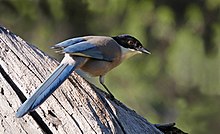| Iberian magpie | |
|---|---|

| |
| In Parque natural de la Sierra de Andújar, Spain | |
| Conservation status | |
 Least Concern (IUCN 3.1) | |
| Scientific classification | |
| Domain: | Eukaryota |
| Kingdom: | Animalia |
| Phylum: | Chordata |
| Class: | Aves |
| Order: | Passeriformes |
| Family: | Corvidae |
| Genus: | Cyanopica |
| Species: | C. cooki |
| Binomial name | |
| Cyanopica cooki Bonaparte, 1850 | |
| Synonyms | |
|
Cyanopica cyana cooki | |
The Iberian magpie (Cyanopica cooki) is a bird in the crow family. It is 31–35 cm (12–14 in) long and similar in overall shape to the Eurasian magpie (Pica pica) but is slenderer with proportionately smaller legs and bill. It belongs to the genus Cyanopica.
Taxonomy
The Iberian magpie was formally described in 1850 by the French naturalist Charles Lucien Bonaparte based on a specimen that had been collected by Samuel Edward Cook in Spain. Bonaparte coined the binomial name Cyanopica cooki, to replace the preoccupied Pica cyanea. The specific epithet was chosen to honour the collector. The type locality was restricted to Madrid by Harry Forbes Witherby in 1923. The species is monotypic: no subspecies are recognised.
This taxon was formerly treated as conspecific with the azure-winged magpie (C. cyana), but this population is 5,400 miles (9,000 km) away from those in eastern Asia. Genetic analysis has suggested that Iberian and azure-winged magpies are distinct species. Other common names include Iberian azure-winged magpie, Cook's azure-winged magpie, and Spanish azure-winged magpie.
Description
It has a glossy black top to the head and a white throat. The underparts and the back are a light grey-fawn in colour with the wings and the feathers of the long (16–20 cm) tail are an azure blue.
Distribution and habitat
The Iberian magpie occurs in southwestern and central parts of the Iberian Peninsula, in Spain and Portugal. However, it can sometimes be spotted also in south-western France, and recently its presence has been reported even in north-western Italy. It inhabits various types of coniferous (mainly pine) and broadleaf forest, including parks and gardens in the eastern populations.
Behaviour and ecology

Often Iberian magpies find food as a family group or several groups making flocks of up to 70 birds. The largest groups congregate after the breeding season and throughout the winter months. Their diet consists mainly of acorns (oak seeds) and pine nuts, extensively supplemented by invertebrates and their larvae, soft fruits and berries, and also human-provided scraps in parks and towns.
This species usually nests in loose, open colonies with a single nest in each tree, same mean clutch size is 6.2 eggs, but only 32% of nesting attempts are successful, with an average 5.1 young fledged.
References
- BirdLife International. (2017) . "Cyanopica cooki". IUCN Red List of Threatened Species. 2017: e.T22732302A112290599. doi:10.2305/IUCN.UK.2017-1.RLTS.T22732302A112290599.en. Retrieved 20 June 2021.
- ^ "Cyanopica cooki". Avibase.
- Bonaparte, Charles Lucien (1850). Conspectus Generum Avium (in Latin). Vol. 1. Leiden: E.J. Brill. p. 382.
- Gould, John (1837). The Birds of Europe. Vol. 3: Insessores. London: Published by the author. Plate 217 text.
- ^ Mayr, Ernst; Greenway, James C. Jr, eds. (1962). Check-List of Birds of the World. Vol. 15. Cambridge, Massachusetts: Museum of Comparative Zoology. p. 244.
- Jobling, James A. (2010). The Helm Dictionary of Scientific Bird Names. London: Christopher Helm. p. 117. ISBN 978-1-4081-2501-4.
- Witherby, Harry Forbes (1923). "Cyanopica cyanus gili, subsp. nov". Bulletin of the British Ornithologists' Club. 43: 74.
- Gill, Frank; Donsker, David; Rasmussen, Pamela, eds. (December 2023). "Crows, mudnesters, birds-of-paradise". IOC World Bird List Version 14.2. International Ornithologists' Union. Retrieved 6 February 2024.
- ^ Handbook of the Birds of the World vol 12. p. 598.
- Fok, Koon Wah; Wade, Christopher M.; Parkin, David T. (2002). "Inferring the phylogeny of disjunct populations of the azure-winged magpie Cyanopica cyanus from mitochondrial control region sequences". Proc. R. Soc. Lond. B. 269 (1501): 1671–1678. doi:10.1098/rspb.2002.2057. PMC 1691084. PMID 12204127.
- Kryukov, A.; Iwasa, M. A.; Kakizawa, R.; Suzuki, H.; Pinsker, W.; Haring, E. (November 2004). "Synchronic east-west divergence in azure-winged magpies (Cyanopica cyanus) and magpies (Pica pica)". Journal of Zoological Systematics and Evolutionary Research. 42 (4): 342–351. doi:10.1111/j.1439-0469.2004.00287.x.
- "Iberian Magpie". oiseaux-birds.
- "Gazze aliazzurre in Lombardia". YouTube.
- Alonso, J.A.; Muñoz-Pulido, R.; Bautista, L.M.; Alonso, J.C. (1991). "Nest-site selection and nesting success in the azure-winged magpies Cyanopica cyana in central Spain" (PDF). Bird Study. 38: 45–51. doi:10.1080/00063659109477066.
- Muñoz-Pulido, R.; Bautista, L.M.; Alonso, J.C.; Alonso, J.A. (1990). "Breeding success of azure-winged magpies Cyanopica cyana in central Spain" (PDF). Bird Study. 37: 111–114. doi:10.1080/00063659009477046.
| Taxon identifiers | |
|---|---|
| Cyanopica cooki |
|